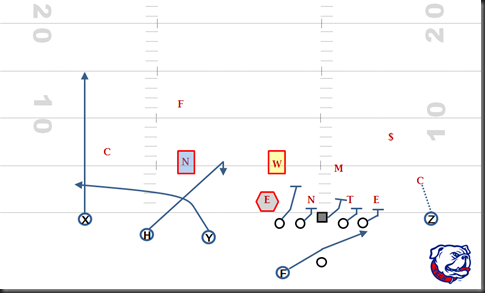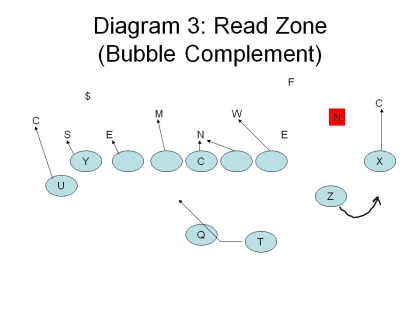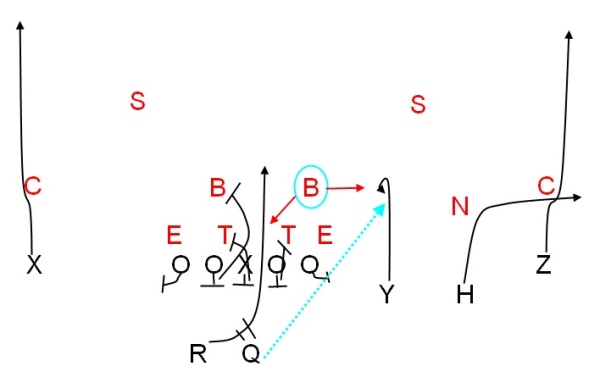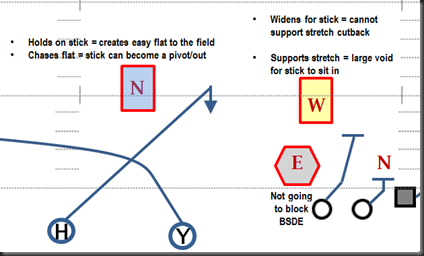 Making the Defender wrong every time. (H/T: Brophy).
Making the Defender wrong every time. (H/T: Brophy). Last week I began examining a new trend in college football by examining the theory behind combining plays together and letting the quarterback choose which option to take post-snap. Today I want to drill down further and discuss how an offensive coaching staff can put this idea into practice. As is probably obvious, timing and rules limit what concepts can be combined. The read must be simple enough for the quarterback to actually execute. Practically speaking, this generally means that the QB's decision should be determined by reading a single defender. It is impractical for the QB to read a full downfield pass progression and then run a draw--defenders could not be blocked for that length. Conversely, by rule the offensive line cannot run block only for the offense to throw the football downfield.
As such, this concept works best when it is a quick pass read combined with a run play, all determined by the QB reading a single defender. This keeps it simple enough for the offense, while combining a dynamic approach that constrains the defense. This also largely solves the linemen downfield problem, as linemen are provided a three yard cushion, more than enough time to throw the quick pass. At its most basic, combining a run with a pass concept generally takes one of two forms (Combining pass concepts is a slightly different idea which I will address later).
Run with a Wide Receiver Screen
This is not a new concept, as I discussed with the bubble screen. Nonetheless it is an effective constraint to prevent teams from cheating on the frontside zone play.

It also stretches the defense's response to tempo, alternatively hitting them quickly on the perimeter or alternatively making them play gap sound and stretching them horizontally on the zone play (oftentimes stretch). The combined concepts can take multiple forms. The aforementioned bubble is one. Tom Herman at Iowa State employed another, which was to combine the inside zone with the flash screen. Again the idea is to stretch the defense horizontally and prevent the defense from cheating to stop the run. It also again provides two different tempos for the defense to stop. The 'look screen' is a third way to do it, which is where the QB simply throws to the wide receiver hot if the defensive back provides too much space. In all cases the read is similar--if the QB sees the relevant defensive back cheating inside he throws it quickly to the wide receiver while the rest of the offense runs the pre-prescribed play.
Stick with a Run Play
Coaches have taken the combined pass-run concept a step further, however, by combining the stick passing play with a run play. The 'stick' route is run by the inside tight end or wide receiver, where he simply runs to six yards and then settles down in the hook/curl area. Stick can be combined with several run plays. This combined concept has perhaps been made most famous by Dana Holgorsen, who combines stick with a draw play. The goal is to make the strong side linebacker wrong every time. If the linebacker stays to play the run, the QB 1) throws the stick. If he extends to cover the route, however, then the QB 2) turns and hands to the draw. (H/T: Smart Football).

But the combination is not limited to the draw. Tony Franklin combines stick to the backside with stretch. In contrast to Holgorsen, Franklin wants to attack the weak side linebacker, essentially eliminating another defender from the box against the frontside run. (H/T: Brophy).

If the Will linebacker stays to provide run support, the QB throws the inside stick. But if Will stays to defend the stick, suddenly the linebacker who has cutback support is eliminated from defending the frontside stretch play.

Just as with traditional option plays, then, the idea of combining concepts allows the quarterback to attack one defender to make them wrong every time and thus evening out the offense's perpetual arithmetic disadvantage. But it also has the added advantage to attack the defense across the field horizontally, rather than amassing at the point of attack. Next week I will examine how Urban Meyer may employ this idea this fall.

